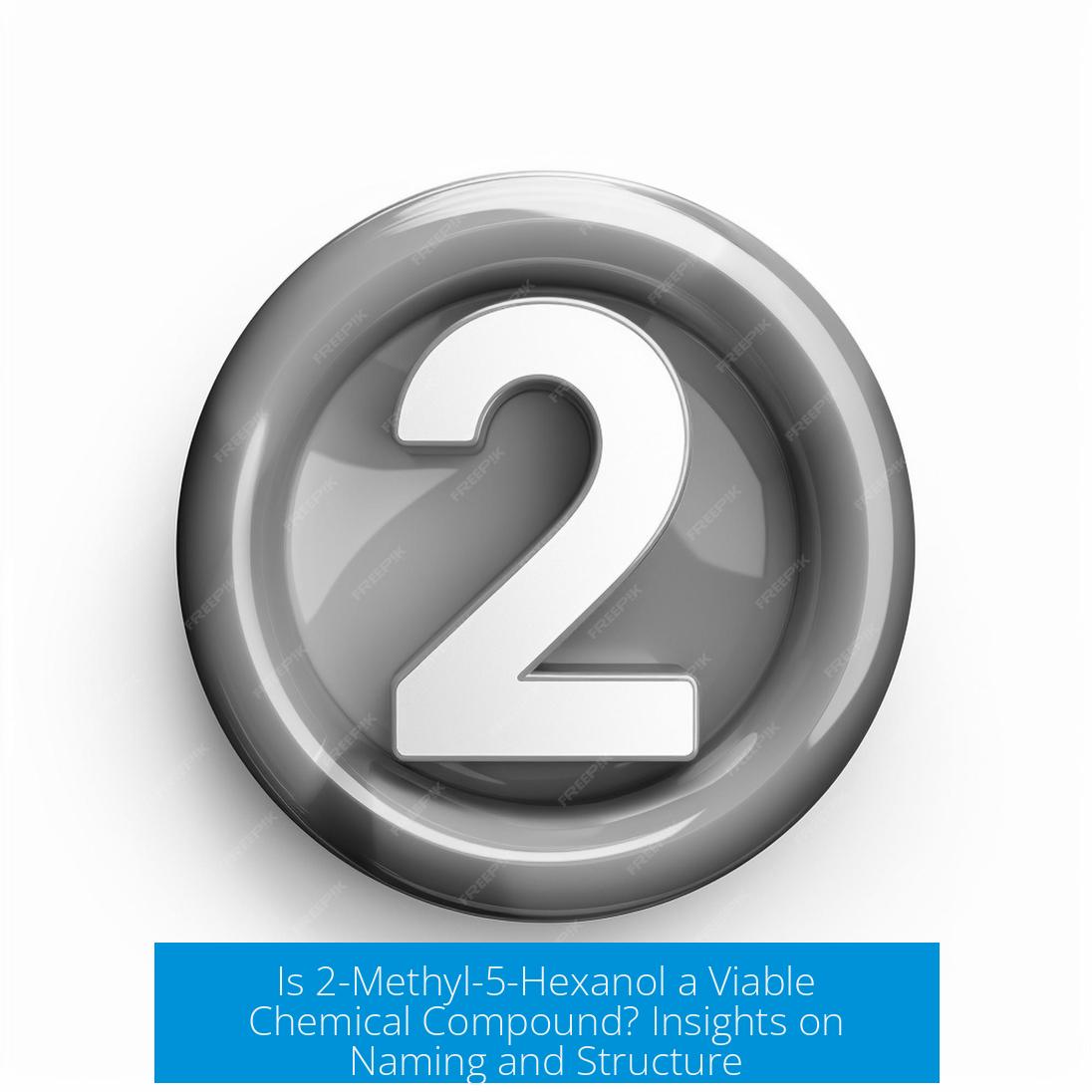Is 2-Methyl-5-Hexanol Possible?

2-Methyl-5-hexanol is chemically possible, but according to IUPAC nomenclature, the preferred and correct name is 5-methyl-2-hexanol. This reflects the prioritization rules that apply when naming alcohols, where the hydroxyl (-OH) group receives the lowest possible number. The compound corresponds structurally to a six-carbon chain with a methyl substituent on carbon 5 and a hydroxyl group on carbon 2.
Chemical Feasibility of 2-Methyl-5-Hexanol
The compound 2-methyl-5-hexanol represents a saturated hexanol molecule with a methyl substituent and an alcohol group. Such a structure is chemically stable and can exist under standard laboratory conditions. It has the molecular formula C7H16O, stemming from a six-carbon chain (hexane) with modifications.
- The hydroxyl functional group (-OH) characterizes the molecule as an alcohol.
- A methyl group attached at one of the carbon atoms changes the physical and chemical properties compared to hexanol alone.
- No steric hindrance or instability arises from this combination of substituents.
As such, the synthesis of this compound is feasible using standard organic chemistry techniques, and it is well-documented in chemical databases, including its enantiomerically-defined forms like (2R)-5-methylhexan-2-ol.
IUPAC Nomenclature and the Importance of Priority
Understanding whether “2-methyl-5-hexanol” is the correct name hinges on chemical nomenclature standards set by IUPAC. The naming rules prioritize the identification of the principal functional group first. In this case, the alcohol (-OH) group takes naming precedence.
Numbering the Chain

The carbon chain receives numbering that gives the hydroxyl group the lowest possible number. Here, that means numbering the chain so that the -OH group is at carbon 2 instead of carbon 5.
- Numbering from the end closest to the hydroxyl group is mandatory.
- The methyl substituent, attached farther along the chain, gets numbered after the position of the alcohol.
Correct Naming of the Compound
Thus, the correct systematic name is 5-methyl-2-hexanol or using updated IUPAC style, 5-methylhexan-2-ol. This adjustment aligns with the priority of functional groups and clear communication across chemical literature and databases.
Incorrectly naming it as “2-methyl-5-hexanol” ignores this priority, which may lead to confusion or misinterpretation of the molecule’s structure.
Structural Elucidation and Depiction
Visualizing the molecule helps clarify how substituents are assigned positions and influence naming:
- The parent chain contains six carbon atoms arranged linearly (hexane backbone).
- The hydroxyl (-OH) group is bound to carbon 2.
- A methyl group is attached to carbon 5.
This arrangement is represented as follows:
CH3–CH(OH)–CH2–CH2–CH(CH3)–CH3
The central -OH group signifies the alcohol, while the methyl group substitutes one of the carbons at position 5.
Comparison With Similar Compounds

When examining similar molecules, naming conventions become more complex if unsaturation appears or other functional groups are included. For example:
- 5-methyl-2-hexenol, which includes a double bond, must be named carefully to indicate double bond position, such as 5-methylhex-3-en-2-ol.
- Similarly, triple bonds or additional substituents increase the complexity and require precise nomenclature.
But for saturated compounds like 5-methyl-2-hexanol, the naming remains straightforward once priority rules are applied.
Data and Properties of 5-Methyl-2-Hexanol
5-Methyl-2-hexanol (C7H16O) appears in various chemical databases, providing information about physical, chemical, biological, and toxicological properties. For example:
- Chemical Abstracts Service (CAS) identifiers and PubChem compound IDs catalog its molecular structure and enantiomers.
- Properties such as boiling point, density, and solubility correlate with its molecular structure.
- Studies exist highlighting its use in research or synthesis pathways.
This data confirms the compound’s existence and utility within chemical and biological contexts.
Practical Naming and Representation in Research
In practical research or computational contexts, naming conventions may simplify referencing molecules:
- SMILES notation or other graphical tools often accompany these names to avoid ambiguity.
- Researchers prefer visual representations (e.g., skeletal formulas or 3D models) for presentations.
- Automated chemical databases sometimes accept shorthand or the most up-to-date IUPAC name to index compounds efficiently.
Thus, while “5-methyl-2-hexanol” is correct formally, scientists often balance rigor with practicality based on context.
Summary of Key Points

- 2-methyl-5-hexanol is chemically feasible but must be named 5-methyl-2-hexanol.
- Alcohol functional group receives priority in numbering for IUPAC approval.
- Structural depiction confirms the position of the hydroxyl and methyl substituents.
- Naming complexity grows with unsaturation or additional groups, requiring updated nomenclature.
- Reliable chemical data exist for 5-methyl-2-hexanol, supporting its practical and research relevance.
- SMILES and structural images often complement formal naming in research communication.
Is 2-Methyl 5-Hexanol Possible? A Deep Dive into Chemical Naming and Structure
Is 2-methyl 5-hexanol possible? Short answer: not quite, at least if you’re following the official IUPAC naming rules. But this chemistry story runs deeper than a simple yes or no. Let’s unpack why the name “2-methyl 5-hexanol” doesn’t quite pass muster and what the correct name actually should be—and why it matters.
At first glance, “2-methyl 5-hexanol” sounds legit. It implies a six-carbon chain (hexanol), with a methyl group attached to carbon 2 and a hydroxyl (-OH) group at carbon 5. But here’s the rub: organic nomenclature has an ironclad rule— the hydroxyl group takes naming priority.
The Hydroxyl Group is the VIP in Naming
When naming alcohols, the -OH group can’t be treated like just another substituent. It’s the “parent” functional group and demands the lowest possible number on the carbon chain. This rule helps chemists quickly identify the functional group in complex molecules. So rather than calling the compound “2-methyl 5-hexanol,” IUPAC insists on numbering the chain so the alcohol is closer to carbon 1, not 5.
What does that look like in practice? Instead of “2-methyl 5-hexanol,” the name flips to 5-methyl 2-hexanol. Here, the hydroxyl is on carbon 2 while the methyl group is on carbon 5—giving that alcohol group the priority position it demands.
Modern IUPAC Nomenclature: Embracing Complexity and Clarity

With chemistry becoming ever-more complex, IUPAC recently updated its rules to handle subtleties—especially when double or triple bonds are involved. So the name now often appears as 5-methylhexan-2-ol, with hyphens clarifying positions.
This naming style might make chemists’ tongues twist — many students and even professors grumble about how cumbersome these “new-ish” names sound. But clarity wins over awkward pronunciation in official circles. It’s about unambiguous identification. Still, does everyone use these lengthy names daily? Probably not.
Practical Naming: The Balance Between Formality and Usability
Let’s get real. Scientists hate to wrestle with cumbersome names in everyday work. When research depends on swift communication, many lean on SMILES codes or graphical structures. SMILES (Simplified Molecular-Input Line-Entry System) codes turn molecules into computer-friendly text strings, avoiding verbal tongue-twisters altogether.
During presentations or casual talks, a quick molecular image often says more than a mouthful of hyphenated names. So while “5-methylhexan-2-ol” is the official label on paperwork, chemists might just flash a diagram or mention “that compound with a 5-methyl and 2-alcohol” and call it a day.
Could 2-Methyl 5-Hexanol Actually Exist as a Molecule?
Chemistry speaks not just in names, but in molecules. Could a compound *with* an OH at carbon 5 and a methyl branch at 2 physically exist? In pure chemical structure terms, yes, but naming conventions stand firm.
Technically, you could draw a hexanol chain with an -OH at carbon 5 and a methyl at carbon 2. But standard practice forces you to renumber the chain to minimize the number for the hydroxyl group. The molecule exists *structurally*, but looking at the name “2-methyl 5-hexanol” would mislead. For example, in PubChem, this compound appears as (2R)-5-methylhexan-2-ol, with the 2 position hydroxyl prioritized.
Why Does This Matter? The Stakes of Proper Naming
Imagine you’re ordering a chemical for research or submitting a paper. Naming mistakes could cause confusion or ordering errors. The difference between “2-methyl 5-hexanol” and “5-methyl 2-hexanol” isn’t just semantics—it’s clarity and reproducibility.
Properly naming a compound ensures everyone, from labs across the world to database AI, identifies the exact molecule without second-guessing. That’s why naming conventions exist—communication, precision, and safety.
Breaking It Down Chemically
- “Hexanol” tells you there’s a six-carbon chain with an alcohol group.
- The suffix “-ol” confirms the presence of –OH, which must get the lowest number.
- “5-methyl” shows a methyl group attached to carbon 5.
- The chain numbering must start closest to the -OH so the alcohol’s carbon gets the lowest possible number.
In “2-methyl 5-hexanol,” numbering starts at the methyl end, incorrectly prioritizing the methyl group’s position over the alcohol, which breaks the rules.
Examples Make It Crystal Clear
Take alcohols with double bonds or multiple substituents. The names get long, like 5-methylhex-3-en-2-ol, which indicates a double bond at carbon 3 and an alcohol at carbon 2.
It’s a mouthful, sure, but it’s clearer than guessing or arguing for a less precise name like “2-methyl 5-hexanol.”
Summary: So, Is 2-Methyl 5-Hexanol Possible?
- Strictly by IUPAC naming, no—because the alcohol must have the lowest number, meaning the name “5-methyl 2-hexanol” (or newer “5-methylhexan-2-ol”) is correct.
- Structurally, yes, the molecule could exist, but still must be named so the hydroxyl position is honored.
- In practical research, chemists often rely more on molecular drawings and SMILES codes to avoid cumbersome names.
- Modern naming rules embrace complexity for clarity but can feel awkward to pronounce.
Have you ever stumbled over a chemical name too complex to say? Chemical naming is a bit like a language with fierce rules. It demands precision, and sometimes, a little patience.
Next time you see a name like “2-methyl 5-hexanol,” pause and ask: “Is this really following the naming laws?” Chances are, it needs a bit of a makeover—and a number shuffle—to get it right.
After all, chemistry is all about clarity. And no one wants confusion when naming their favorite molecule.
Is 2-methyl 5-hexanol chemically possible?
Yes, 2-methyl 5-hexanol is chemically possible. It can also be represented as (2R)-5-methylhexan-2-ol based on its structure.
What is the correct IUPAC name for 2-methyl 5-hexanol?
The correct name is 5-methyl-2-hexanol. The hydroxyl group takes priority, so numbering starts from the carbon with the OH group.
Why is the name 2-methyl 5-hexanol not preferred in IUPAC rules?
Because the alcohol group must get the lowest possible number. This changes the numbering, making 5-methyl-2-hexanol the correct form.
How do newer IUPAC rules affect naming compounds like 5-methyl-2-hexanol?
Newer rules can make names longer or more complex. They help clarify structure, especially with double or triple bonds, but sometimes make pronunciation harder.
What is the best way to represent or communicate this compound in research?
Using structural images or SMILES code is often easier and clearer than complicated IUPAC names, especially in computational work and presentations.





Leave a Comment